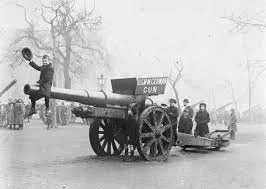First World War:
The First World War, also known as World War I, was a global conflict that lasted from July 28, 1914, to November 11, 1918. It involved many of the world's great powers and was centered in Europe.
Causes:
1. Assassination of Archduke Franz Ferdinand: The immediate trigger was the assassination of Archduke Franz Ferdinand of Austria-Hungary on June 28, 1914, in Sarajevo by a Serbian nationalist.
2. Alliance Systems: Complex alliance systems existed in Europe, with major powers grouped into the Triple Entente (France, Russia, and the United Kingdom) and the Triple Alliance (Germany, Austria-Hungary, and Italy).
3. Imperialism: Rivalries over colonial territories and imperial ambitions contributed to tensions among European powers.
4. Nationalism: Intense nationalism and competition for dominance fueled animosities between nations.
5. Military Buildup: Arms race and military buildup among major powers heightened the potential for conflict.
Major Powers Involved:
1. Allied Powers (Entente Powers):
- France
- Russia (until 1917)
- United Kingdom
- Italy (from 1915)
- United States (from 1917)
2. Central Powers:
- Germany
- Austria-Hungary
- Ottoman Empire
- Bulgaria
Major Battles and Fronts:
1. Western Front: Characterized by trench warfare, major battles included the Battle of the Somme, Battle of Verdun, and others.
2. Eastern Front: Fought primarily between Germany, Austria-Hungary, and Russia.
3. Gallipoli Campaign: Allied attempt to open a sea route to Russia through the Dardanelles.
4. Italian Front: Battles between Italy and Austria-Hungary along the mountainous border.
United States Involvement:
1. Initially, the United States adopted a policy of neutrality.
2. Factors leading to U.S. entry included unrestricted submarine warfare by Germany and the interception of the Zimmermann Telegram.
3. The U.S. officially entered the war on April 6, 1917.
End of the War:
1. Armistice: An armistice (ceasefire) was signed on November 11, 1918, ending the hostilities on the Western Front.
2. Treaty of Versailles: The formal peace treaty was signed on June 28, 1919, at the Palace of Versailles, imposing harsh terms on Germany and establishing the League of Nations.
Consequences:
1. Casualties: The war resulted in a massive loss of life, with millions of military and civilian casualties.
2. Political Changes: The war led to the collapse of empires (Austro-Hungarian, Ottoman, Russian, and German) and the emergence of new nations.
3. Economic Impact: The war had a profound economic impact, with significant destruction and changes in global trade.
4. Treaty of Versailles: The treaty's terms, including territorial losses and reparations, contributed to political instability and resentment in Germany, setting the stage for World War II.
The First World War was a watershed moment in history, marking the end of an era and setting the stage for significant geopolitical and social changes in the 20th century.
